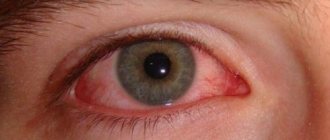Requests for eye products are a common occurrence in Russian pharmacies. Despite the fact that most drugs used in ophthalmology are dispensed by prescription, in some cases, the pervostolnik can help the buyer in choosing a drug. Some OTC drugs are particularly used for conjunctival infections. What remedies can be recommended in this case and what should visitors with prescriptions for drugs in this group pay attention to? We will answer these questions in our review of ophthalmic drops.
Types of conjunctivitis
First of all, it is important to understand that for any ophthalmological problems, a doctor’s consultation is necessary, and the client should be warned about this first. There are various pathological conditions for which drugs with radically different mechanisms of action are prescribed [1]:
- Bacterial conjunctivitis associated with bacterial pathogens. Most often, it is bacteria that cause inflammatory processes in the conjunctiva. The basis of treatment is local antiseptic and antibacterial eye drops. The discharge from the eye is pus.
- Viral conjunctivitis caused by the development of a viral infection, usually adenoviruses [1]. The basis of therapy is antiviral eye drops. The discharge from the eye does not have the character of pus.
- Allergic conjunctivitis. First-line drugs are systemic and local antihistamines and intranasal corticosteroids, and less commonly, cromoglycates. There are other symptoms of hay fever.
Of course, the primary care physician should not engage in differential diagnosis and search for the causes of the disease, but he can and should recommend anti-inflammatory eye drops of the OTC group.
It is necessary to clearly distinguish between medications that are used for different types of inflammation of the conjunctiva. We talked about drops that are used for allergic conjunctivitis quite recently. This material will discuss drugs used to treat inflammation of the conjunctiva of the eye, viral and bacterial conjunctivitis.
What should I warn the client about?
Terms of use.
To ensure that the drops remain sterile after opening, it is important not to touch the tip of the tube to the eye during use and to close it tightly after each use. In addition, it should be borne in mind that the shelf life of eye drops after opening may be limited: this information will certainly be in the instructions for use.
Storage conditions.
A common mistake made by many consumers is storing all eye drops in the refrigerator. In fact, drugs in this group do not always have to be stored at a cool temperature, including after opening. Be sure to draw the visitor’s attention to this, warning how exactly specific drops should be stored.
Drugs used to treat bacterial conjunctivitis can be divided into 4 categories:
- Antimicrobial;
- Antiseptic;
- Corticosteroids;
- Combined.
Consumer choice and the doctor's recommendations are limited to the first two subgroups, which include over-the-counter drugs.
Neuroprotectors in the treatment of glaucoma
In the treatment of glaucoma, drugs that have a neuroprotective effect stand out. They help improve microcirculation in the optic nerve area and improve the nutrition of nerve cells. A number of studies have shown the high effectiveness of this group of drugs, which improve the prognosis and course of glaucoma. It is especially advisable to prescribe neuroprotectors in advanced forms of the disease and in advanced cases.
Interestingly, some antiglaucoma drops (beta blockers, prostaglandins) also have a slight neuroprotective effect.
The main groups of neuroprotectors are presented below:
1. Medicines to improve microcirculation (trental, ginkgo biloba, dicynon). 2. Drugs to improve the regeneration of nervous tissue (cinnarizine, picamelon, nootropil, fezam). 3. Substances to activate the nutrition of nerve cells (Semax, Cortexin, retinalamine, Noben, Cerebrolysin). 4. Vitamins and antioxidants (mexidol, emoxipin, aevit, ascorbic acid, vitamins B and E, lutein complex, riboxin, histochrome, mertilen forte, erisod).
Neuroprotectors should definitely be prescribed in the combined treatment of glaucoma. Drugs from different groups combine well with each other and even potentiate the effect. To select the optimal treatment regimen with neuroprotectors, you need to contact an experienced ophthalmologist.
Antimicrobial eye drops
Used only for bacterial conjunctivitis. Typical signs are redness, the appearance of purulent, sometimes profuse yellowish discharge, sticking together the edges of the eyelids and eyelashes [2, 3].
Over-the-counter drugs
Sulfacetamide (albucid)
Very popular drops from the Soviet past. The active substance belongs to the group of sulfonamides. The drug is active against gram-positive and gram-negative cocci, as well as some gram-negative microorganisms and even intracellular ones - in particular, chlamydia. However, many bacteria develop resistance to sulfacetamide, and therefore its effectiveness is sharply reduced.
Available in two forms - 10% (children from 0) and 20% (children over 2 months and adults).
Sulfacetamide drops should be applied frequently, every 2-3 hours (that is, 6-8 times a day). As you recover, the frequency of use may be reduced. When instilling drops, a burning sensation may be felt.
The drug must be stored in the refrigerator: the instructions for some medications require storage at a temperature no higher than 15 °C, and others at no higher than 25 °C.
Chloramphenicol
Being a broad-spectrum antibiotic, it is active against most microorganisms that cause damage to the conjunctiva, including staphylococci, streptococci and Haemophilus influenzae.
NB! Some chloramphenicol TN in the form of eye drops belong to the Rx group. Before dispensing a drug, you should carefully study the instructions to make sure that a particular product can be sold without a doctor's prescription.
Chloramphenicol antimicrobial eye drops should be stored in the refrigerator (temperature 8–15 °C) [4].
Prescription drugs
The list of prescription antibacterial eye medications with antibacterial effects is quite long. Most drugs are fluoroquinolones. Their spectrum of activity covers the majority of microorganisms associated with bacterial inflammatory diseases of the conjunctiva [5].
Today, the following INNs for antibacterial eye drops are registered in the Russian Federation:
- Macrolides - azithromycin;
- Fluoroquinolones - norfloxacin, ofloxacin, gatifloxacin, levofloxacin, lomefloxacin, moxifloxacin, ciprofloxacin;
- Aminoglycosides - azithromycin, tobramycin;
- Fusidic acid.
To reduce the risk of bacteria developing drug resistance, it is important to strictly follow your doctor's instructions regarding the frequency and duration of use of eye drops.
Recommendations for selection
The most important thing: the remedy for eye redness is selected in accordance with the specific reason due to which the scleral vessels dilate. This means that you cannot do without contacting an ophthalmologist. Only he can make an accurate diagnosis and tell you why your eyes are red. The specialist conducts not only a visual examination, but also biomicroscopy - examination using a special microscope. If necessary, he does additional tests to evaluate the functioning of the tear glands.
In addition, many drops have contraindications. For example, not all products are suitable for children and pregnant women. Individual intolerance to the components included in their composition is also possible.
If the drops recommended by your doctor seem too expensive to you, do not look for a budget replacement on your own, discuss a possible alternative with a specialist.
The ophthalmologist will find the cause of eye redness and prescribe appropriate treatment with drops
Perhaps you need not just drops, but several varieties of them. In this case, they need to be instilled into the eyes one at a time, with an interval of at least 10 minutes.
If there is no suspicion of a serious pathology, and the discomfort is not constant, you can independently choose moisturizing drops for eye redness. They imitate natural tears and help relieve dryness.
Even if you do not have a serious eye disease, you should use the drops if you:
- spend a lot of time in front of a computer screen;
- you read a lot;
- wear makeup often;
- wear contact lenses.
There are manufacturers who produce solutions in disposable dropper tubes. They are simple and convenient to use, and you can always carry them with you or take them on trips, so that if redness occurs due to overwork, you can quickly solve the problem.
Antiseptic eye drops
The doctor can prescribe them for both bacterial and viral conjunctivitis. Signs of a viral infection of the conjunctiva are severe redness, itching, scanty transparent discharge or its absence [2].
Over-the-counter drugs
Boric acid + zinc sulfate
Zinc sulfate has an antiseptic, astringent, drying and local anti-inflammatory effect, and boric acid has an antiseptic effect.
A burning sensation when instilling drops is a side effect that does not require discontinuation of the medication [4]. Store eye drops in a cool place (temperature 12–15 C°).
Picloxidine
An antimicrobial drug active against staphylococci, streptococci, Proteus, some viruses and fungi. Used for bacterial infections of the anterior part of the eye. There are no age restrictions.
Prescription drugs
Benzyldimethylmyristoylaminopropylammonium
An eye antiseptic with a pronounced antimicrobial effect against gram-positive and gram-negative bacteria, including strains with antibiotic resistance. The spectrum of activity includes fungi, chlamydia, and adenoviruses [6].
When instilled, a slight burning sensation and discomfort may occur, which disappears after 15–20 seconds.
Decamethoxin
An antiseptic with a fairly wide spectrum of antimicrobial action. Active against gram-positive (staphylococci, streptococci), gram-negative bacteria, as well as a number of fungi and even viruses and chlamydia. With complex treatment, it enhances the effect of antibiotics. Resistance of microorganisms to decamethoxin develops slowly. It can also be used in newborns to prevent blenorrhea [4].
Methods for diagnosing keratitis
It is possible to select an adequate treatment for keratitis only after determining the causes of the disease. The main diagnostic tool is the slit lamp: it is used to determine the depth, extent, and localization of inflammatory foci. If a bacterial, fungal or viral nature of the disease is suspected, bacteriological and cytological studies of smears from the surface of the cornea are prescribed. A fluorescein test may be prescribed to check the integrity of the epithelium, and an allergy test to identify allergens.
Corticosteroids
Since monopreparations containing glucocorticosteroids do not have an antibacterial effect, they are used only for non-purulent forms of conjunctivitis. Today, only one monocomponent eye drops with GCS are registered in the Russian Federation.
Dexamethasone
After use, short-term blurred visual perception is possible, which is important to warn the client about.
Combination eye drops
Combined eye drops, as a rule, contain 2 main components - a glucocorticosteroid and a substance with an antibacterial effect. The first is usually dexamethasone or betamethasone, and the second is fluoroquinolones or aminoglycosides. There are also three-component combinations, which include 2 antibiotics and a steroid.
All these drugs belong to the prescription group.
Dexamethasone + tobramycin
Dexamethasone has a pronounced anti-inflammatory, antiallergic effect, and tobramycin disrupts protein synthesis and the permeability of the cytoplasmic membrane of bacteria associated with infectious processes of the conjunctiva. The combination of GCS and an antibiotic can reduce the risk of severe infection.
Dexamethasone + gentamicin
It is used for infections of the anterior chamber of the eye, and for allergic processes accompanied by bacterial infection. When instilled, it can cause a burning sensation and short-term impairment of visual acuity, which leads to a slowdown in mental and physical reactions. Therefore, it is not recommended to use drops immediately before working with machinery or driving vehicles.
Dexamethasone + ciprofloxacin
A universal drug - used in both ophthalmological and otorhinolaryngological practice. When used, may cause burning, redness and itching of the eyes.
Betamethasone + gentamicin
It is used for diseases of the eyes (including conjunctivitis) and ear (acute and chronic external otitis media, etc.). When instilled, swelling and burning of the conjunctiva may develop.
Framycetin sulfate + gramicidin + dexamethasone
Framycetin sulfate is an aminoglycoside with a corresponding spectrum of activity. Gramicidin is an antibiotic of the tyrothricine group, increases the spectrum of action of framycetin against staphylococci, and also provides an antistreptococcal effect.
When instilled into the eyes, a short-term burning sensation may occur, which goes away on its own and does not require discontinuation of the drug.
Dexamethasone + neomycin + polymyxin B
Neomycin is active against staphylococci, streptococci, Haemophilus influenzae and a number of other pathogens; the spectrum of action of polymyxin B covers pseudomonads and Klebsiella.
Causes of red eyes
There are a number of reasons that provoke dilation of blood vessels on the surface of the sclera. This is first of all:
- eye strain caused by prolonged work with documents, reading in poor lighting, or spending many hours in front of a monitor;
- external irritants - wind in the face, ultraviolet radiation, low temperature;
- getting dust, sand, or any foreign bodies into the eye;
- long stay in a room in which the air conditioner operates - it dries the air, and the itching and burning sensation in the eyes may be due to the fact that the mucous membrane is not sufficiently moistened;
- allergic reactions – to plant pollen, house and office dust, animal hair;
- long driving at night;
- the use of low-quality cosmetics, mascara, eye shadow or the use of cosmetics in too large quantities;
- exposure to tobacco smoke;
- alcohol abuse;
- various eye diseases, such as glaucoma, scleritis or conjunctivitis.
Mobile gadgets can cause red eyes
Separately, it is worth noting the redness of the eyes that occurs when wearing contact lenses. This symptom is especially typical for those who have just started using lenses - this is how the body reacts to a foreign body in the eye. As you get used to it, the problem will disappear, but if you wear lenses for a long time and the redness does not go away, this is a serious reason to seek medical help.
Find your nearest salon
Redness also appears in cases where you do not properly care for your lenses, do not pay enough attention to cleaning them, and do not replace them on time. Wearing contact lenses for long periods of time during the day can also cause vasodilation, which is manifested by redness. Take breaks and give your eyes a break from the lenses.
How does blepharitis manifest?
In the first days after the onset of inflammation, the patient's eyes begin to itch, the eyelids become red and swollen. After 2-3 days, secondary symptoms of pathology appear:
- thickening of the edges of the eyelids;
- sensation of a foreign object;
- lacrimation;
- pain and pain in the eyes in bright light;
- heaviness in the eyelids;
- mucous and purulent discharge;
- rashes, ulcers on the eyelids and around the eyes.
These symptoms can hardly be called specific. Almost all eye diseases are accompanied by similar symptoms. However, the forms blepharitis takes are very diverse. They vary depending on the causes of the disease. At the same time, its types, in turn, determine the method of treatment.
What is blepharitis?
Blepharitis refers to several ophthalmological diseases that are characterized by an inflammatory process on the eyelids. It is quite difficult to treat. This is due to the localization of inflammation, as well as the recurrent nature of the pathology. It often takes a chronic form and bothers a person during periods when his immune system is weakened.
Blepharitis develops as follows. Pathogenic microorganisms enter the excretory ducts of the eyelids, which contain the meibomian and ciliary glands. They can be dormant for a long time. As soon as a person catches a cold or is overtired, microbes begin to multiply. This immediately leads to inflammation. There are other provoking factors.








